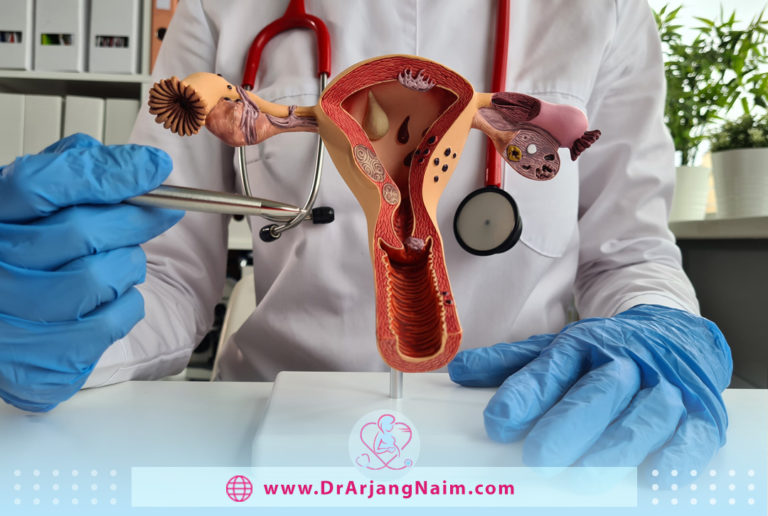The uterus is held in place by the pelvic muscles and ligaments. Suppose these muscles and ligaments become stretched and weak and cannot hold the uterus well; the uterine prolapse. The so-called uterine prolapse occurs when the uterus deviates from its normal position and hangs or falls into the vagina.
Uterine prolapse can be complete or incomplete. When the uterus is partially sunken into the vagina, it is incomplete prolapse. When the uterus hangs so much that some of its tissue protrudes from the vagina, it is a complete prolapse. Uterine prolapse often affects postmenopausal women with one or more vaginal deliveries.
Mild uterine prolapse usually does not require treatment. But uterine prolapse that causes discomfort or interferes with daily life needs treatment.

Symptoms
Women with minor uterine prolapse may not have any symptoms. Moderate to severe prolapse may cause symptoms, such as:
- Vaginal bleeding
- Increased discharge
- The feeling that you’re sitting on a ball
- Problems with sexual intercourse
- A pulling or heavy feeling in the pelvis
- The uterus or cervix protruding out of the vagina
- Difficulty passing stool or constipation
- Difficulty emptying your bladder or recurring bladder infections
You should immediately see a doctor and be treated if these symptoms occur. This condition can impair bowel, bladder, and sexual function without proper attention.
What are the stages of uterine prolapse?
The stages are:
- The uterus drops into the upper part of the vagina
- The uterus falls into the lower part of the vagina
- The uterus is protruding from the vagina
- The entire uterus slips outside of the vagina

Causes
Uterine prolapse is caused by the weakening of pelvic muscles and supporting tissues. The causes of the weakening of pelvic muscles and tissues are:
- Vaginal delivery
- Age at the first delivery
- Delivery of a large baby
- Difficult labor
- Delivery or trauma during childbirth
- Being overweight
- Lower estrogen level after menopause
- Chronic cough or bronchitis
- Repeated heavy lifting
- Chronic constipation or straining with bowel movements
How serious is a prolapsed uterus?
The prolapsed uterus can disrupt normal activities and be uncomfortable. Very mild cases may not require treatment or cause discomfort. However, severe cases may make urinating or having a normal bowel movement difficult. Health care will treat it when the symptoms of the disease begin to interfere with daily life.
Risk factors
Risk factors include:
- Prior pelvic surgery
- Aging
- Obesity
- Giving birth to a large baby
- Having one or more vaginal births
- Chronic constipation
- Being Hispanic or white
- Family history of weak connective tissue
- Chronic coughing, such as from smoking
What conditions are associated with uterine prolapse?
When the surrounding muscles become too weak, other organs in the pelvic area can become out of position. Some other types of pelvic organ prolapse include:
- Cystocele: When the bladder falls into or out of the vagina.
- Rectocele: When the rectum enters or exits the vagina.
- Enterocele: When part of the small intestine protrudes into the vagina.

How to reduce the risk of uterine prolapse
Some factors, such as multiple natural births or menopause, cannot be avoided. But there are ways to reduce the risk of prolapse. A few lifestyle tips that can reduce the risk of prolapse include:
- Maintain a healthy weight
- Do Kegel exercises
- Stop smoking
- Exercise regularly
- Use proper lifting techniques when carrying heavy objects
- Prevention of constipation
Proper lifting techniques to avoid uterine prolapse
Several weight lifting tips can help prevent injury, including:
- Do not lift objects that are very heavy by yourself, also avoid lifting heavy objects above your waist level
- Before you lift an object, make sure you have a firm footing
- To pick up objects lower than your waist, keep your back straight and bend at the knees. Never bend from the waist while the knees are straight.
- Stand next to the desired object, tighten your legs, contract your stomach muscles and lift it using your leg muscles.
- Straighten your legs and stand without twisting, taking care to move your legs forward when lifting objects
- If you lift an object from a table or a high surface, bring it to the edge of the table as close to your body as possible
- To lower or place objects on the floor, act the same as lifting them.
A doctor can diagnose uterine prolapse by evaluating the symptoms and performing a pelvic exam. During this exam, the doctor inserts a speculum device, which allows them to see inside the vagina and examine the vaginal canal and uterus. The doctor may ask the person to pretend to have a bowel movement to determine the degree of prolapse.
Diagnosis
Uterine prolapse is often diagnosed during a pelvic exam. During a pelvic exam, the health care provider will ask the person to:
- Bear down as if having a bowel movement. This can help the provider assess how far the uterus has slipped into the vagina.
- The doctor asks the client to tighten the pelvic muscles as if to stop the flow of urine. This test checks the strength of the pelvic muscles.
- Also, the doctor asks the patient to fill out a questionnaire. This helps the provider assess how the prolapsed uterus affects the person’s life. This information also helps in making treatment decisions.
- If there is severe urinary incontinence, tests may be done to measure bladder function. This test is called urodynamics.
Treatment
There are surgical and non-surgical options for treating uterine prolapse. The health care provider chooses the treatment path based on the severity of the prolapse, general health, age, and whether or not the woman wants children in the future. Treatment is generally effective for most people.
Nonsurgical options
There are non-surgical options for treatment.
Exercise
Special exercises called Kegel exercises can help strengthen the pelvic floor muscles. This may be the only treatment needed in mild cases. To do Kegel exercises, tighten your pelvic muscles as if you are holding in urine. Hold the muscles tight for a few seconds, and then release. Repeat ten times. You can do these exercises anywhere and anytime (up to four times a day).
Vaginal pessary
A pessary is a doughnut-shaped rubber or plastic device placed around or under the lower part of the uterus (cervix). This device helps hold the uterus and keep it in place. A healthcare provider fits and inserts a catheter that should be cleaned regularly and removed before sex.
Diet and lifestyle
Diet and lifestyle changes may help relieve symptoms such as constipation. Increasing the consumption of water and fiber reduces the frequency of defecation. Maintaining a proper weight puts less stress on the hip muscles when standing or walking.
Surgical options
Surgery is used if non-surgical options do not help.
Hysterectomy and prolapse repair
A prolapsed uterus may be treated by removing the uterus in a surgical procedure called a hysterectomy. This procedure can be done through an incision in the vagina (vaginal hysterectomy) or through the abdomen (abdominal hysterectomy). A hysterectomy is major surgery, and removing the uterus means pregnancy is no longer possible.
Prolapse repair without hysterectomy
This procedure involves returning the uterus to its normal position. Uterine suspension may be performed by reattaching the pelvic ligaments to the lower part of the uterus to hold it in place. Depending on the technique the provider uses, the surgery can be done through the vagina or the abdomen.
The bottom line
In most cases, the outlook for uterine prolapse is very good. Seeking treatment and lifestyle changes (maintaining a healthy weight and exercising) can help prevent prolapse from recurring. Talk to your healthcare provider about any concerns you may have about prolapse. Your provider can help develop a treatment plan and good lifestyle habits to prevent future prolapse.
Uterine prolapse is a common condition in people who have had multiple natural births or gone through menopause. Symptoms will vary depending on how far your uterus has slipped out of place, but they can be very uncomfortable. Talk to your doctor if you have signs of prolapse, such as a vaginal bulge or pressure in your pelvis. There are treatments to help you feel better before other organs are affected.
Arjang Naim MD can help you in this field and give you the necessary guidance.
Additional questions
- What causes an enterocele?
Increased pressure on the pelvic floor is the main cause of any form of pelvic organ prolapse. Conditions and activities that can cause or contribute to small bowel prolapse or other types of prolapse include pregnancy and childbirth. Chronic constipation or straining with bowel movements.
- What is the average age for a prolapse?
Prolapse occurs between the mid-30s and 100s. It is related to natural changes in women’s bodies, such as childbirth and menopause. However, it is common after menopause when the body’s estrogen levels change, which allows ligaments to stretch and organs to shift.
- What is the diet to lose belly fat with prolapse problems?
Unfortunately, you cannot lose belly fat with a diet. Losing belly fat naturally requires a whole-body weight loss approach. Here are some simple weight management tips to lose belly fat:
- Don’t skip meals
- Avoid artificial sweeteners that cause bloating and affect bowel movements
- Avoid weight loss diets or products that slow down bowel movements and cause constipation with prolapse
- Drink adequate water and low-energy fluid
- Avoid late-night snacks before going to bed
- Write down what you eat and drink
- Monitor your incidental food intake
- What vitamin is good for prolapse?
Supplements that can be helpful include:
- Mineral and Multivitamin: A good quality multivitamin and mineral form the foundation of a supplement program to ensure you’re getting a little bit of everything.
- Vitamin C with bioflavonoids: Vitamin C, as well as bioflavonoids, help build collagen, so if you suffer from prolapse or stress incontinence, or both, it’s important to supplement with these nutrients.
- Vitamin A: This vitamin helps the body produce collagen and strengthen cartilage.
- Manganese: This mineral is needed for healthy bones, cartilage and skin.
- What does a vaginal prolapse look like in a woman?
In more serious cases of vaginal prolapse, the top of the vagina may protrude outside the vaginal opening. Symptoms of vaginal prolapse include feeling pressure or fullness in the vagina, like sitting on a small ball, and feeling that something has fallen out of the vagina.
References:
https://www.mayoclinic.org/diseases-conditions/uterine-prolapse/diagnosis-treatment/drc-20353464
https://my.clevelandclinic.org/health/diseases/16030-uterine-prolapse#diagnosis-and-tests
https://www.healthline.com/health/uterine-prolapse#prevention
https://www.healthline.com/health/uterine-prolapse#prevention
https://www.betterhealth.vic.gov.au/health/conditionsandtreatments/prolapsed-uterus




